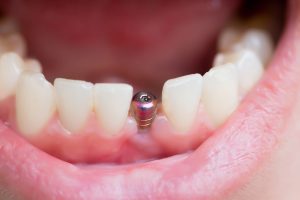 If your dentist or oral surgeon tells you that a bone graft is in order, it might sound a little intimidating. But these procedures needn’t be a cause for concern. A bone graft is a routine procedure that allows the oral surgeon to create a foundation for dental implants, strengthen weak or thin areas of the jaw, or aid in reconstructive surgery.
If your dentist or oral surgeon tells you that a bone graft is in order, it might sound a little intimidating. But these procedures needn’t be a cause for concern. A bone graft is a routine procedure that allows the oral surgeon to create a foundation for dental implants, strengthen weak or thin areas of the jaw, or aid in reconstructive surgery.
A bone graft typically attaches a piece of processed bone to your own jaw bone with stitches or, in the case of a larger graft, screws. Over a period of time– usually over a month– your body grows new bone cells over the implant. That is one way to counteract atrophy of the jaw bone that can occur after tooth extraction, to reinforce bone thinned from disease, trauma, or other factors.
For example, a dental extraction in which the tooth was never replaced can often cause a deterioration of the bone where the tooth once had been. A graft would be necessary to restore the bone to its former strength and stability. Or a graft might be necessary in the case of a cosmetic or medical procedure that altered the shape or alignment of the jaw, such as a sinus lift. Another instance in which a bone graft might be helpful is if an infection, such as that caused by a dry socket after a tooth extraction, from extreme periodontal disease, or other cause, led to weakened jaw bone tissue.
Years ago, bone grafts were more complicated and had a bigger impact on the patient. That was because the graft was usually constructed from the patient’s own bone, harvested from elsewhere in the body. These days however, it’s far more common to use special materials designed specifically for dental bone grafts, limiting the intrusion and recovery time you’ll experience.
First, the oral surgeon will take X-Rays of your mouth and make a model from which he or she can plan the procedure. You’ll discuss the timeline of the procedure, anesthesia options, and how exactly the surgeon will approach your procedure. You may have a small metal cylinder inserted along with the bone graft to later serve as the “root” for your future implants– that’s a technique called osseointegration. The surgeon might also craft a temporary cosmetic tooth prosthetic so that your smile isn’t affected while the bone cells grow.
Once the bone graft has successfully taken, the oral surgeon or dentist can than proceed with the next step of your treatment, whether that means a denture fitting, a dental implant, a crown, etc. If you have an osseointegration or abutment, you may have an additional procedure to ensure your gums are healing correctly around the cylinder and around your future implant.
It takes time and patience to work with your body to create the most functional, best looking new tooth possible. But the results are well worth it. That’s why Ocoee Oral Surgery is one of the most trusted providers of bone graft procedures in the Cleveland, Tennessee area. We work with you to create top-quality dental solutions and put you at ease every step of the way.
